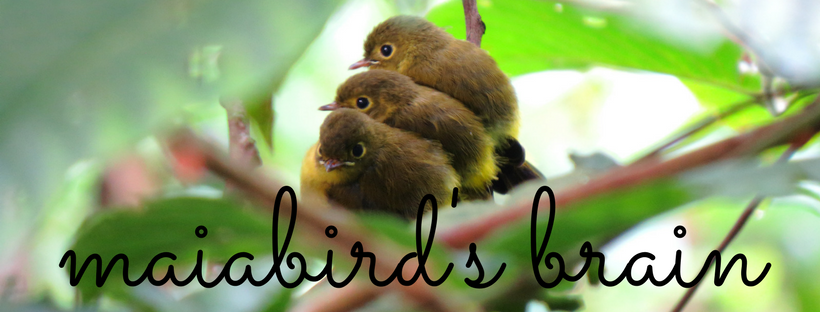I've always just read about stories and reports from fellow birdwatchers about the spectacle of hundreds and even thousands of migrating raptors filling the skies up north. The most raptorwatching I've done was in Tanay, Rizal and it has been years since I last participated in the seasonal count. So when I was invited to join the count and help out in a symposium in Ilocos Norte, I said yes!
Trinket, Lala, Jelaine, and I took the 8PM deluxe Florida Bus (Cubao station) to Pagudpud which cost us Php700. The ride took about 12 hours with multiple stopovers but it wasn't as bad as I expected. We slept most of the trip and at around 8AM, we got off the bus right outside the
Panzzian Resort! So convenient!
We met up with Alex and Tere, and joined the Japanese guests from the Asian Raptor Research and Conservation Network (ARRCN) for breakfast.
 |
| Breakfast area by the beach in Panzzian =) |
After our yummy breakfast, we got ready to go to the neighboring municipality of Adams to check out if any raptors have taken to the skies, and of course birding! Joining us were more birders from the WBCP. Along the road, we already spotted a
Rufous-bellied Hawk Eagle thermalling above. We stopped at the DENR birding station and spotted a few
Grey-faced Buzzrads, some
Chestnut Munias, and a curious
Paddyfield Pipit. Rufous Hornbills could be heard calling from further away but they did not make an appearance.
 |
| Watching a small group of thermalling raptors |
 |
| Paddyfield Pipit |
We continued our ride to Adams, stopping every now and then when we spot birds along the road. We had a very close encounter with a pair of Luzon Hornbills, feeding on ripe fruits just by the side of the road!
 |
| Sadly the only photo I got of the male Luzon Hornbill |
After a few more stops (and me FINALLY seeing Rufous Hornbills for the first time -- YAY!), we arrived at Adams and registered with the local police station. The Chief of Police, some more officers, and even the Mayor's wife and son joined our group.
 |
| Registering at the Adams police station |
 |
| Alex hitched a ride with the policemen to the site |
We arrived at a hill beside the town cemetery and overlooking so much green. We spent some time scanning the skies atop the hill and weren't disappointed. A big group of Grey-faced Buzzards thermalled above us, wow-ing us and even eliciting excited squeals from Lala =)
The next few days were dedicated to conducting symposiums about raptors, birdwatching, and conservation. The first one was held in the Panzzian Resort and was attended by people from neighboring barangays and municipalities.
 |
| Art activity for the participants |
 |
| Trinket giving a talk about birdwatching |
The second symposium was held at the Cagayan State University in Claveria. In attendance were students, DENR personnel, barangay representatives, and even the Mayor of Claveria.
 |
| Mayor Asela Sacramed giving the opening remarks |
 |
Toru Yamazaki of the ARRCN giving a talk about why the
Grey-faced Buzzards should be saved |
 |
Michael Calaramo of Northwestern University talking about
the natural heritage of northern Luzon |
 |
Dennis Salvador of the Philippine Eagle Foundation shared
some awesome videos of the Philippine Eagle
and talked about community involvement in conservation |
 |
Doc Lala Espanola facilitating the conservation
action planning after the talks |
Claveria is one of the municipalities lining the northernmost edge of the island of Luzon and has been found to be the entry and exit point of migrating raptors. Even at the CSU campus, raptors could be seen thermalling overhead.
 |
| Raptor watching from the balcony of the Dean's office |
 |
We travelled from Pagudpud to Claveria
and later to Sanchez Mira |
Birdwatchers have only recently discovered this site but the locals have been noticing the seasonal presence of the Grey-faced Buzzards for generations. Locally called
sawi (
sah-wee), they have been considered a delicacy, much like a seasonal fruit. Aside from being "free pickings" and easy targets (they are shot while perched, tired and resting on coconut trees), the
sawi is also believed to have aphrodisiac properties O.o
 |
| Can you spot the two GFBs in the photo? |
It is a sad reality there BUT there is a silver lining. During the symposium in Claveria, a number of hunters attended and listened to the talks and sat down with Alex and Jelaine to discuss the issue of hunting. I think them being at the symposium is a big step towards change and the eventual end of hunting of the
sawi.
 |
| Alex addressing the crowd and the Mayor |
 |
Jelaine introducing a video about the role raptors play
as natural pest controllers |
The next day, we went to join the watch at Sanchez Mira, where student volunteers from CSU do the counts. We spent some time in the tent set up for the counters and enjoyed watching kettles of Grey-faced Buzzards fly in and seeing the birds glide down to perch on the coconut trees in the surrounding areas.
 |
| Count site with student volunteers |
Here's a short video from that morning:
The north is truly "raptor country" and it is encouraging that the people there are willing to listen and are learning to appreciate the true worth of their seasonal visitors. There is still a lot of work to be done to change what has been considered the "norm", but when the community is willing to listen and learn, then you know that the wheels have started turning and the situation can only get better, not only for the sawi but for all the other raptors and birds in their area.
 |
| Immature Rufous-bellied Hawk-Eagle |
 |
| Philippine Serpent Eagle |
























